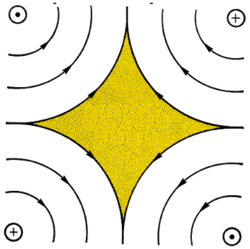Physics:Horne Hybrid Reactor
The Horne Hybrid Reactor (HHR) is a development type of nuclear fusion research device produced by Horne Technologies in 2017. A prototype demonstration device that uses a combination of fusion technologies and implementation of Rare earth - Barium - Copper Oxide (REBCO) superconductors in a "high-beta" style magnetic configuration.[1][2][3][4] Heating is achieved through the use of inertial electrostatic confinement, improved by a magnetically-shielded grid, and a "high-beta" fusion core.[5]
History
Started in 2008, Horne Technologies is a company that develops technology to optimize containment of plasma for the purpose of improving the energy balance of fusion devices.
In 2016 the first prototype was developed and produced. First plasma was initiated in 2017.[5]
Design
To increase efficiency in the prototype, Horne Hybrid Reactor utilizes three major fusion technologies to optimize containment, inertial electrostatic confinement, a magnetically-shielded grid, and a "high-beta" fusion core. The geometric magnetic configuration of the first generation prototype is that of a biconic cusp.[5]
Inertial electrostatic confinement
A fusor is a device that uses an electric field to heat ions to conditions suitable for nuclear fusion. The machine generates an electric potential difference between two metal objects inside a vacuum. Positive ions fall down this voltage drop, building up speed. If they collide in the center, they can fuse. In the instance of the Horne Hybrid Reactor the grid is replaced with a coil containing high-temperature superconductors. The superconducting ring is then biased electrically to produce the effect of a fusor.

File:Horne Hybrid Reactor.webm
Superconducting, magnetically-shielded grid
In fusors, the potential well is made with a wire cage. Because most of the ions and electrons fall into the cage, fusors suffer from high losses. By using a grid that is magnetically shielded it is theorized that these losses can be reduced.[8]
The Horne Hybrid Reactor prototype utilizes second generation high-temperature superconducting wire. Rare earth - Barium - Copper Oxide (REBCO) superconductors are cooled externally with pumped liquid nitrogen[1], these superconducting electromagnets create a magnetic field of 5000 Gauss at each coil and are the enabling technology to run the device continuously.[5] This is in contrast to similar groups working on high-beta confinement concepts include Polywell and Lockheed Martin with the Compact Fusion Device, both utilizing conventional electromagnets that must be run in pulsed mode.[6]
High-Beta fusion core
Another advantage of the magnetically-shielded grid is it allows for a magnet configuration that sets up a "high-beta" fusion core. This is a condition where the plasma pushes back against the field, causing a plugging effect and creates a central null field region where the plasma is momentarily contained.[9] In the fusion power field, plasma is confined using large magnets. Since the temperature of the fuel scales with pressure, reactors attempt to reach the highest pressures possible.
Additional work
With demonstration of an initial prototype and technology, a second generation device is currently under construction.[5]
See also
- Fusor
- Inertial electrostatic confinement
- Beta (plasma physics)
- Polywell
- Lockheed Martin Compact Fusion
References
- ↑ 1.0 1.1 Wang, Brian (June 6, 2018). "Horne Technologies has superconducting IEC fusion device and hope for net power by 2020". https://www.nextbigfuture.com/2018/06/horne-technologies-has-superconducting-iec-fusion-device-and-hope-for-net-power-by-2020.html.
- ↑ "Fusion Industry Association". https://www.fusionindustryassociation.org/.
- ↑ Neumann, Klaus (August 31, 2018). "Author". Superconductor Week Vol 32, No 7: 5–7. http://www.superconductorweek.com/free-content/horne-technologies-developing.
- ↑ Stafford, Michael (2018-03-28). "Exploring the potential of fusion". The Silver State Post.
- ↑ 5.0 5.1 5.2 5.3 5.4 "Horne Technologies - Fusion, make it work" (in en). http://www.hornetechnologies.com.
- ↑ 6.0 6.1 Thorson, Timothy A. (1996). Ion flow and fusion reactivity characterization of a spherically convergent ion focus (Thesis). University of Wisconsin-Madison. OCLC 615996599.
- ↑ Thorson, T. A.; Durst, R. D.; Fonck, R. J.; Sontag, A. C. (1998). "Fusion reactivity characterization of a spherically convergent ion focus". Nuclear Fusion. 38 (4): 495. Bibcode:1998NucFu..38..495T. doi:10.1088/0029-5515/38/4/302.
- ↑ Hedditch, John; Bowden-Reid, Richard; Khachan, Joe (2015). "Fusion in a magnetically-shielded-grid inertial electrostatic confinement device". Physics of Plasmas 22 (10): 102705. doi:10.1063/1.4933213.
- ↑ Park, Jaeyoung; Krall, Nicholas A.; Sieck, Paul E.; Offermann, Dustin T.; Skillicorn, Michael; Sanchez, Andrew; Davis, Kevin; Alderson, Eric; Lapenta, Giovanni (1 June 2014). "High Energy Electron Confinement in a Magnetic Cusp Configuration". arXiv:1406.0133v1 Freely accessible [physics.plasm-ph].


